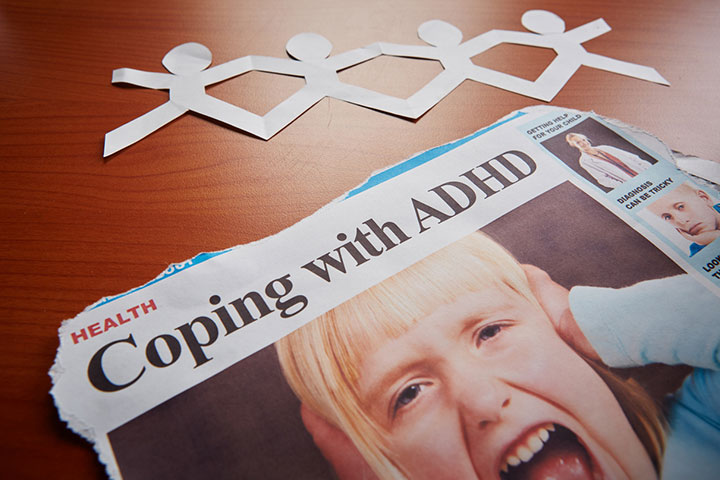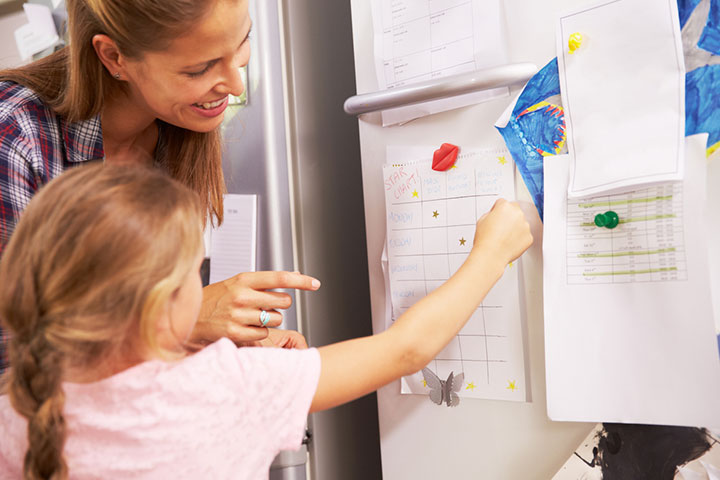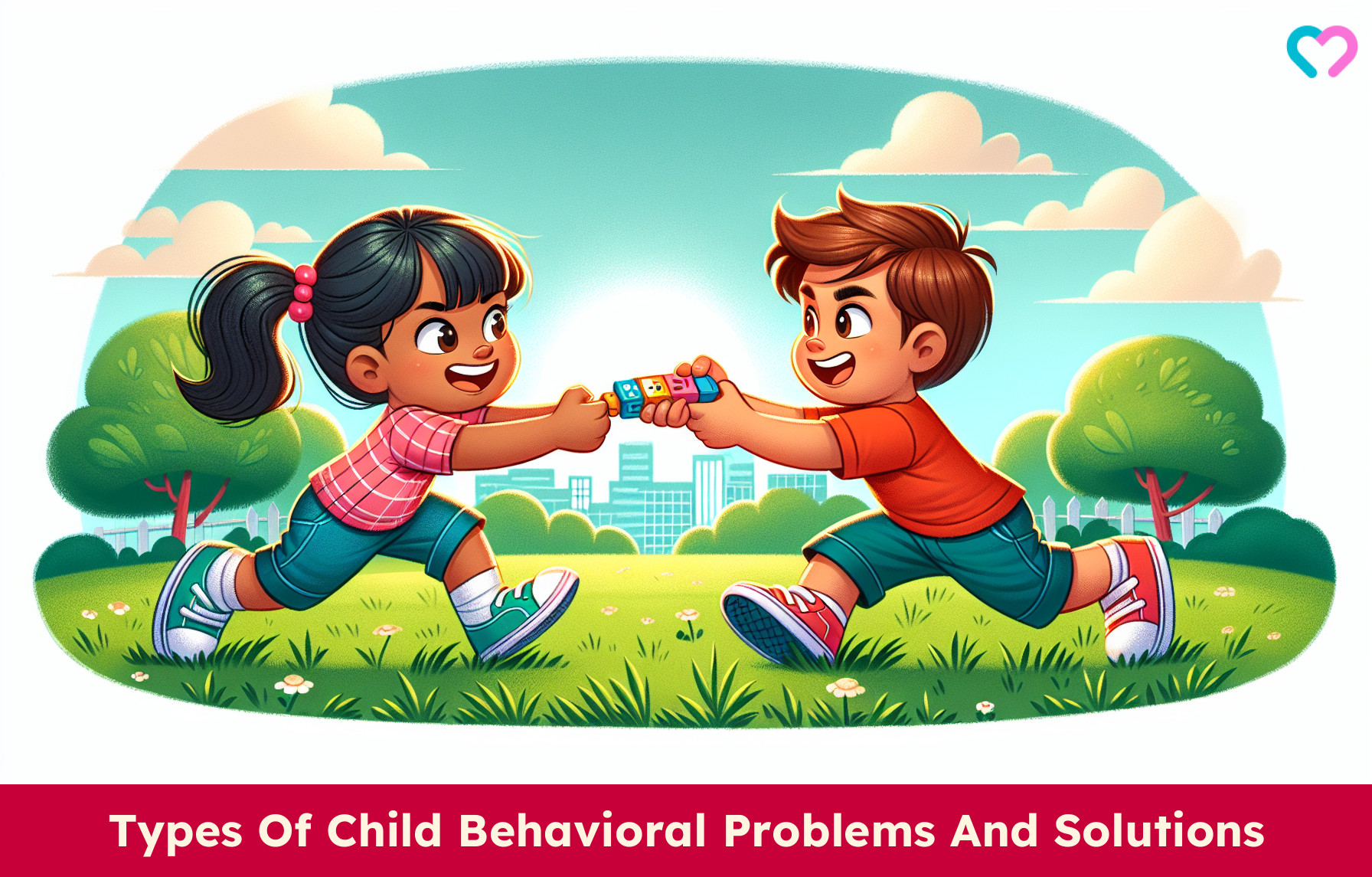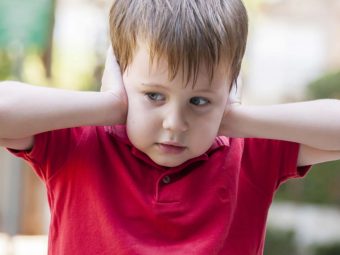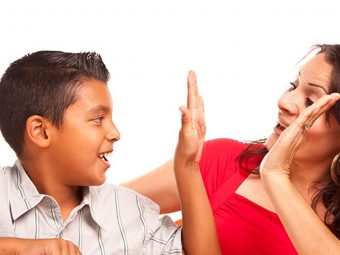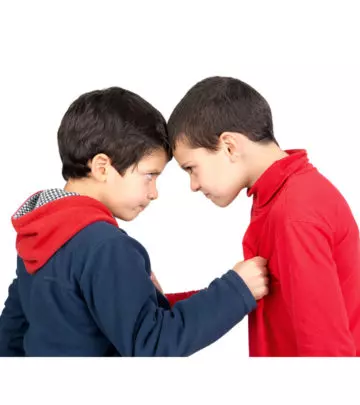
Image: Shutterstock
All children are different and display unique behavioral characteristics. However, when their behaviors become challenging, parents start exploring child behavior problems and solutions.
On most occasions, children are considered to have normal behaviors if they are age-appropriate and do not cause any harm. However, if their actions become difficult to manage, you should pay attention to them. For example, if children become emotional too often, cause destruction, or behave rudely, it may signify a behavioral issue.
You can handle most of these issues with positive parenting and behavioral therapy. Further, it is important to talk to your children and support them in overcoming the problem. However, if you feel the problem is becoming unmanageable, consider taking professional help.
This post elaborates on the common behavioral problems in children, their signs and symptoms, and tips for handling them efficiently.
What Is Normal Behavior In Kids?
There is no yardstick for normal behavior. Instead, it depends on a child’s age, personality, emotional regulation, and development as well as the upbringing environment (1).
In general, a child’s behavior is deemed to be normal if it is socially, developmentally, and culturally appropriate. You can consider a child’s behavior normal even if it does not meet societal or cultural expectations, but is otherwise age-appropriate and not harmful.
How do you differentiate a misbehaving child from a normal one?
Signs And Symptoms Of Abnormal Behavior in Children
Image: IStock
Children are cute when naughty. A few tantrums, arguments, and yelling once in a while are not abnormal. But if such behavior becomes a daily occurrence, then it is a cause for concern and the child may require behavior modification. Here are some signs and insights into child psychology that indicate your child’s behavior is abnormal (2).
- Your child seems to have difficulty managing their emotions. They have frequent emotional outbursts, and minor things bother them.
- It is not normal if your eight-year-old becomes impulsive and displays destructive behavior like hitting, throwing things, screaming, etc.
- Your otherwise talkative child withdraws into a shell, talks back, and seems rude for no reason.
- Your little child may be lying more often than you realize. Stealing or taking things that do not belong to them becomes a habit.
- Your child’s behavior is affecting their performance at school. For instance, your child may be getting into fights, going late to class, or missing classes.
- Spats and disagreements your seven-year-old has with peers become problems that affect their social life. That is not normal.
- Unable to focus on one thing, gets restless, extremely lazy, or disoriented.
- Indulges in sexual behaviors that are not age-appropriate.
- Your child starts questioning your instructions and does not respond to discipline. They may defy rules just to challenge you.
- It is not normal for children to harm themselves or even think about self-harm. So, if they are harming themselves physically and having suicidal tendencies, you should be worried.
It is important to note that the rational part of the brain is not yet developed in children under three and are, therefore, driven by their emotions. As they grow older, rationality improves but they still need support from us in managing their emotions. This is normal.
Also, minor abnormal behaviors can be corrected through behavior therapy and parenting style changes. What are such behavior disorders in children that can be dealt with some effort?
9 Common Behavioral Problems In Children
It is common for children to break the rules and go against the norm to ‘test’ authority. Only that way do they understand what behavior is appropriate and what is not. Read on to learn about the behaviors that children tend to exhibit from time to time and the right parenting skills to handle a child with behavior problems.
1. Disrespect and backtalk
Image: IStock
When your three-year-old talks back to you, it may seem funny and adorable. But when your seven-year-old shouts out a ‘no’ every time you tell them to do something, it can get on your nerves. If not handled properly, backtalk can lead to arguments between parents and children.
So what do you do?
- If your child talks back but follows your instructions, then ignore it. Ignoring backtalk may be okay if the behavior is not threatening or destructive.
- If the child follows instructions, even though they talk back, appreciate that they did what you asked, even if they didn’t want to. You can then explain that it is okay to be angry but not to speak to you disrespectfully (3).
- But if the child’s responses are threatening others or themselves, you need to pay attention to what they say and handle it carefully.
- Do not respond impulsively. Let the child calm down and then address what they said. Tell them calmly about what behavior is acceptable and what is not.
- Set limits and make them aware of the consequences. Do not threaten, just state facts that they won’t get ice cream or go to the movie if they talk back. For instance, tell them if they continue to yell and shout, they will have to forgo dinner. However, if they stop shouting and listen to you, they will get something nice for dinner. Such give-and-take will look less controlling but give the option to the child.
- Set expectations, but you can be a little flexible sometimes if it makes them happy.
- Finally, take a quick check of how you behave with the children or others when the children are around. Are you rude or disrespectful? If yes, you need to start by changing your behavior.
 Point to consider
Point to consider2. Abusive language
Children scream and yell when they are angry. But if they start swearing even before they are all of ten years old, you should be worried. They may start yelling or using abusive language to bring you into an argument or simply to get their way. When your child uses offensive language and swears, here are mindfulness techniques that should be followed.
- Make sure you are not using such language in front of children.
- Have zero tolerance for verbal abuse at home. There is no excuse for swearing or cursing. So if they use such language, there is a consequence (4).
- Explain the consequences clearly and ensure they are in place. So if your nine-year-old is grounded for one day for abusive language, they will have to miss their soccer practice or music class. There should be no two ways about it.
- If your toddler is using such language, correct them immediately. Tell them it is a “bad word,” and people do not like that word or children who use that word.
If you have used that word in front of your child, apologize immediately. You can even ask your child to remind you that it is a bad word, should you ever say it in front of them.
3. Aggressive or violent behavior
It is okay for children to get angry. But if that anger becomes violent or turns into aggressive behavior in children it is a problem. Mood disorders, psychosis, conduct disorder, trauma, impulsiveness, or frustration can cause aggression in young children (5). At times, your child may resort to violence for self-defense.
Aggression can also be a learned behavior. How is the environment at home? Or is the child learning to be violent at school? If your child tends to react to a negative response by hitting, biting, or kicking, this is what you should do (6).
- The easiest way to respond to aggression in children is to yell back at them. But if you do so, you end up teaching them the wrong things. Your children look up to you to learn how to control their impulses and emotions. So rather than raising your voice, lower your tone and tell them to calm down.
- Reflect their feelings and empathize, but clarify that hitting or kicking, or biting is not allowed. You could say something like, “I know you are angry.” But we do not bite, hit, or kick. No hitting!”
- Tell them what the consequences would be if they turn violent. If you are dealing with a younger child, tell them what they can do instead. Give them an alternative, but don’t leave them hanging. For instance, teach them to use words and phrases like “I’m angry,” or “I don’t like it,” or “I’m not happy about it” when they are upset, instead of resorting to physical violence.
Most importantly, be a good role model and avoid giving them physical punishment. Also, reward positive, non-aggressive behavior.
4. Lying
It is common for children to lie. It is also common for parents to worry when they catch the children lying. You may feel betrayed, hurt, and even wonder if you can trust the child again. But here is what you should do to prevent your child from lying (7).
- Do not take it personally. Instead, think about it from your child’s perspective to understand what compelled them to lie.
- Children may lie when they are scared that the truth might have negative consequences. Appreciate the positives rather than punishing negative behavior for preventing your child’s need for lying.
- Teach them to be honest. Start by being a role model.
- Have consequences for lying rather than arguing or discussing it. Thus, if your child lies, they get to deal with the consequences.
 Quick fact
Quick fact5. Bullying
Bullying is a serious problem that could result in emotional and physical abuse of the victim. Children tend to bully others to feel powerful. Also, bullying resolves their social problems easily. When dealing with feelings becomes difficult, children tend to take on bullying to fix things. If you find that your child has been bullying others, you should act immediately.
- Start teaching your children from an early age that bullying is wrong (8). But, more importantly, explain to them what or who a bully is and give them examples of what bullies do. For example, you can say, “a bully is someone who calls people names, or does mean things to them, or takes their property by force.”
- Set rules and standards in the house early on. Make a statement like “we do not bully in this house” or “you do not get away with such behavior in this house.”
- Watch out for signs of bullying: see if your older kids are trying to bully the younger ones, and rectify the behavior immediately.
6. Manipulation
Manipulation is tricky and a very exhausting behavior to handle. Children tend to act out, lie, or cry to get what they want. If you give in to the bad behavior in children, your child feels justified. For example, if your child throws a tantrum in public for a candy bar and you buy them one, they have just manipulated you.
In simple words, when your child manipulates you, they have power over you. As an adult, you can always break the pattern and stop falling for your child’s manipulative behavior.
- Expect your child to fight every time you say ‘no.’ That way, you can figure out how to deal with their behavior and not fall for manipulation.
- Make it clear that it means no when you say ‘no.’ You can give them a brief explanation of your position, but don’t get into justifying it.
- Avoid discussion, but don’t shut them off completely. Try to listen to their side of the argument as long as the child is respectful and not rude or abusive.
7. Disobedience
Children may test boundaries from time to time and show extreme non-compliance as a way to express their independence, individuality, and autonomy. Studies indicate that childhood non-compliance, aggression, externalization of problems, and disobedience is a relatively stable pattern that peaks in adolescence and subsides by the end of it. There are a few ways you may handle your child’s disobedience (9) (10).
- Do not lose your temper and act aggressively to your child’s rebelliousness.
- If you notice chronic disobedience, observe what triggers their inner turmoil and externalizing behaviors.
- Speak with your child to understand what is causing them to be unhappy or frustrated.
- Model respect within the house and consistently display signs of calmness and cooperation towards your child and family.
- Reward your child when they show coordination, obedience, and cooperation.
- Communication is key. So ensure you resolve conflicts as soon as possible calmly and peacefully.
- Seek professional help if your repeated efforts do not yield results.
8. Lack of motivation and laziness
Your child doesn’t seem interested in doing anything at all. Be it schoolwork, art or music practice or even playing, they refuse to participate. Motivating kids is not easy, especially if they are lazy and tend to find an excuse for not doing anything. When your son or daughter is unmotivated, here is how you can help.
- Don’t get anxious by your child’s behavior. When you do, you may be seen as pushy, which can encourage them to resist you.
- You can tell them the stories about your childhood and share your experiences to inspire and encourage them to try something new.
- Do not force your child to take up a hobby. Instead, give them options and let them choose. Children are more interested in something that they choose.
- Take a step back and check: are you forcing your child to do something? Ask what your child really wants and what motivates them? See your child as a separate person to identify what inspires them.
- Try to find ways to get your children motivated on their own. Self-motivation is more powerful than being driven by others.
- Encourage younger children to take up daily chores by making them fun. For instance, You may set a competition of who picks up the most number of toys or bits of paper from the floor or who makes their bed first.
- For older children, making them responsible for tasks such as washing the dishes, setting the table, or cleaning up to set clear expectations. Set limits like “we will watch a movie once you have finished your chore.”
9. Behavior problems in school
“I hate school!” Is that something you hear your five-year-old say every morning? Children often give parents a hard time by refusing to go to school or complete homework assignments in time. Children could refuse to go to school for many reasons: bullying, academic issues, resistance to authority and rules, or anxiety of being separated from parents.
- Start by getting to the root of the issue. Find out why your child hates school or refuses to do their homework. You may want to help them with their homework if they have trouble with it.
- Your child may take time to perform academically and be okay with the school. Just understand that the change will not happen overnight.
- Offer rewards as a positive reinforcement to encourage good behavior (11). For example, you can say, “you have earned an ice cream tonight because you did your homework without any reminders.”
- Ask the child if they want you to talk to the teacher about a problem they are facing. Let them feel and understand that you are available for them when they face a problem in school. Encourage them by asking what they like doing in school. Help them with their homework, and make it more interesting.
Behavioral problems are not always simple to deal with. Hence, you would have to seek a professional’s help in complicated cases.
When To Get Help
If abnormal behaviors turn into something unmanageable at home, or if your child is repeatedly making a mistake, it is time for you to see a doctor. There could be a deeper reason for your child to behave in a certain way.
The professional will look into the physical and mental health of the child before recommending medications, special therapy, family therapy or counseling.
Under what circumstances could the child’s behavior go out of control?
Behavioral Disorders In Children
Sometimes, abnormal behavior could be a symptom of a behavioral disorder that needs the attention of a medical practitioner. We have listed some of the common behavioral disorders in children (12).
1. Oppositional defiant disorder (ODD)
Oppositional defiant disorder is a disruptive behavior that commonly affects children. Symptoms of this disorder include:
- Gets angry, throws tantrums, outbursts frequently, and has low or no self-esteem.
- Is hostile to rules.
- Annoys others deliberately.
- Blames others for all misdeeds.
 Quick fact
Quick fact2. Conduct disorder (CD)
Children who have CD are known for their delinquent behavior and not obeying rules. According to Mental Health America, “ Conduct disorder is more common among boys than girls, with studies indicating that the rate among boys in the general population ranges from 6 to 16 percent while the rate among girls ranges from 2 to 9 percent” (13).
The typical behaviors are:
- Refusing to follow the rules laid by parents or school authorities.
- Repetitive truancy.
- Trying abusive substances like alcohol, cigarettes, and drugs at a very early age.
- Always ready to fight.
- Aggressive towards animals and pets.
- Use of weapons.
- Lying frequently.
- Indulging in criminal acts like committing burglary, lighting up the property, and breaking into houses.
- Running away from home.
- Suicidal tendencies, although rare.
3. Attention deficit hyperactivity disorder (ADHD)
Image: IStock
It is related to conduct disorder. Common characteristics of the disorder are hyperactivity problems related to attention, impulsive behavior in children, etc. The Italian Journal of Pediatrics published a study that conducted a meta-analysis, revealing the significant global prevalence of attention deficit hyperactivity disorder (ADHD) among children and teenagers. The findings indicate that 7.6% of 96,907 children aged 3 to 12 years and 5.6% of teenagers aged 12 to 18 years exhibit ADHD symptoms.
Symptoms include:
- Trouble focusing on one thing.
- Disoriented when you speak to them.
- Difficulty remembering things, instructions, directions, etc.
- Inattention to detail.
Maria Pistorio, a Philadelphia-based psychotherapist and licensed professional counselor, says, “Trauma produces behavior that looks exactly like ADHD behavior, so it is important to think about what is happening in the child’s world. In addition to that, oftentimes a coercive cycle results in behavioral patterns: children misbehave to get what they want, parents explain why they can’t have that, children tantrum, and parents eventually give in to calm them. In cases like that, the behavior will continue even if the caregiver and child want to change it.”
4. Learning disability
There are different kinds of learning disabilities with varying symptoms. These disorders affect the child’s academic performance and need the expertise of special educators to stay on track.
- Unable to comprehend instructions.
- Short-term memory.
- Poor communication abilities.
5. Antisocial personality disorder
A child suffering from this disorder may become indifferent to others’ problems. Therefore, this disorder may aggravate in later stages of life and result in illegal and unethical activities of the individuals.
6. Underdeveloped social skills
It may sometimes be referred to as Asperger’s syndrome, a narrow developmental disorder.
- Named after an Austrian pediatrician Hans Asperger, this syndrome is usually a result of social interaction impairment.
- The exact cause of this syndrome is unknown. However, psychiatrists consider it as a consequence of a series of symptoms.
- The common symptom of this disorder is difficulty in starting a conversation in public and casual interactions.
Child behavior disorders become more visible as children grow up. However, you can identify abnormal behaviors when your child is still a toddler. It helps you to nip them in the bud.
Behavior Issues In Toddlers
Misbehaving toddlers can be a handful. Reasoning won’t work with them, and punishment will only worsen their behavior. So what do you do? Keep reading to know about common behavior issues at preschool age and how you can help them (14).
1. Interrupting
Little children tend to get excited quickly and cannot control their urge to say what they want to say. As a result, they keep interrupting you all the time. So the next time you have a conversation with your three-year-old, here is what you should do as a form of social skills training.
- Let them finish what they want to say. Hear them out without interruption and then begin talking.
- When they interrupt, explain how mommy did not interrupt and listened when they were speaking. Tell them that they will get a chance to speak after you finish. Say, “let mommy finish, honey” or “mommy has not finished talking.”
2. Screaming
Toddlers, especially those younger than three years, cannot express themselves verbally. Instead, they tend to show their anger or frustration in different ways, including screaming. So, what do you do when your toddler screams?
- Do not scream or shout back at them. It only reiterates that it is okay to scream.
- Teach them to whisper or talk calmly through a game. For instance, you can start with a ‘let’s see who can scream the loudest, and then try ‘who can talk calmly or whisper’.
- Acknowledge their feelings and talk to them. Although you may not have a proper conversation with a one-year-old, words can soothe the child, and they might stop screaming.
3. Running away
Does your child run away and hide when they get angry? Running is dangerous, especially if they do it on roads, supermarkets, or other public places. But you can keep them safe by:
- Keeping an eye on the child’s movements. Always hold their hand when on the road or in other crowded places.
- Showing the child where they can run and where they cannot. Explain by showing people around and what they are doing. For example, show children running in the park to say that it is okay to run there. Likewise, show how people do not run on the streets.
4. Pulling hair
Toddlers may tend to scream, kick and pull hair to fix ‘bad things.’ The only way to make them stop such behavior is to make them understand that it does not work.
- Interrupt your child when they pull their or someone else’s hair to indicate that they should not be doing it.
- Talk it out and explain that it is ‘bad’ to pull hair.
- Do not pull your child’s hair back to show how it feels. They may see it as a game and do it again.
5. Throwing things
Children between the age of 18 months and 3 years are the ones who usually throw things to show their frustration. They tend to throw food, toys, or anything they can get their hands on, just out of curiosity or frustration.
- To avoid damage to valuables, show what your child can throw, like a ball, a bouncy toy, or a fluffy one that doesn’t get damaged.
- Discourage them from throwing things when they are angry or aggressive. Try to ignore when they throw things because of anger. If they persist or keep throwing things that could hurt other children, interrupt immediately and say “No! That is bad” or “No, that hurts!” Tell that in a calm voice.
- Find ways to prevent them from throwing things. For example, in the car, you can tie the toys to their car seat. That way they won’t be able to throw them away.
If you could identify any of the above behavioral problems in your toddlers and older children, you might need some tips to deal with them at home.
8 Tips To Handle Bad Behavior In Children
“Why do kids have to be so annoying?”
If you have asked yourself that question, you are not alone. Misbehaving children can make parenting stressful. So we have put together a few tips and tricks that can help you handle bad or disruptive behavior in children (15).
- Don’t react. When you react or respond to your child’s bad behavior, you are encouraging them.
- Stay positive. When you consider your child as a problem, you cannot find effective ways to deal with their behavior. Focus on rectifying the behavior.
- Be consistent in your reaction or responses to your child’s behavior. More importantly, be consistent in the consequences to driving the point home. Give the same responses to their conduct, and eventually, they will get it.
- That said, it is okay to change the rules sometimes, to change old habits that may have gotten out of hand. For example, cutting down TV time, video game time or other activities for the child’s benefit is okay.
- Be a role model. Change your bad behavior to change your child’s behavior. Children of all ages learn by observation and imitate you because they assume that their parents know the best.
- Disciplining is necessary, but is effective only when it is valid. You need to think well before determining the consequences for your children’s misbehavior.
- Relax. Don’t worry about the usual yelling, arguments, and defiance. It does not hurt to chill out once in a while and take a break from disciplining.
- Use child behavior chart or reward charts to track your child’s behavior patterns. You can create one for a specific behavior or multiple behaviors. You can also have a good manners chart that has details like “said thank you and please”, “helped mom with chores”, “waited for my turn to speak” etc.
Image: IStock
Pistorio observes, “Parents and caregivers sometimes assume that children know what is expected of them. When they don’t, or rather don’t do what parents expect, parents spend effort and energy trying to correct unwanted behaviors by telling them what not to do. That often results in more misbehavior. By paying attention to positive behaviors, using labeled praise of positive opposite behaviors, and giving as little attention as possible to unwanted behaviors, parents and caregivers will see more of the positive behavior.”
Activities For Children With Behavior Problems
A highly effective way to deal with behavior problems in children, especially toddlers, is through activities. There are several activities you can try, and here are a few that we think will be most helpful to you.
- Exercise or physical activities are perhaps the best means to blow steam off. When your child gets excited or angry, getting them to play outside can help relieve them of the energy. If a child’s energy is not properly released, they tend to release it in the ways they know – tantrums, destructive behavior, acting out, etc.
- Role-playing is an excellent activity that can teach your kids to control impulses. One of the major factors affecting a child’s behavior is the lack of self-control.
- Ask your child to read aloud a book or what they are writing. You can try this as a relaxation technique at bedtime when they are still full of energy and need an activity to calm down.
- Storytelling is yet another activity that engages their imagination and lets them use their energy in a positive way. This activity also helps you get an insight into their frame of mind.
Image: IStock
- Play good behavior games and read child behavior books that can teach kids about good deeds such as kindness, sharing, waiting, and saying nice things to each other. Then, when they learn that the good things can be rewarding, they won’t try the bad ones.
Frequently Asked Questions
1. Are disruptive behavior disorders permanent in kids?
Disruptive behavior disorders are behavioral conditions that may last long. The behaviors may change as the child grows, and receiving early treatment can help your child and your family with constructive new patterns for replacing the child’s behavior (16).
2. What is the “black box warning” for certain psychiatric medications?
Boxed warnings (formerly known as Black Box Warnings) are safety-related warnings that the Food and Drug Administration (FDA) assigns to medications. These warnings bring the consumer’s attention to the significant risks of the drug. For example, Selective serotonin reuptake inhibitors (SSRIs) have the boxed warning about an increased risk of suicidal ideation in pediatric patients (17).
3. What are the effective ways to address a child’s attention-seeking behavior?
When addressing attention-seeking behavior in a child, it is essential to acknowledge and appreciate the child’s positive traits alongside their negative behavior. In addition, using distractions, showing empathy by considering their perspective, interacting in a calm and supportive manner, and spending quality time with them can be helpful (18).
4. What are some effective ways to encourage positive communication and conflict resolution skills in children?
You can help children identify their intense emotions and encourage them to write them down in order to understand their innermost feelings. Later, you can assist them in figuring out the source of conflict and finding practical solutions. Additionally, it is vital to foster regular and clear communication by creating a safe and supportive environment where children feel encouraged to express themselves without being judged (19).
Mild tantrums and attitude issues are a common part of children’s behavior. They will most likely grow out of it with age. But if your child is getting out of control to the point of concern, it may be time to step in. And the above mentioned information about childhood behavior problems and solutions can help you. While minor screaming and stubbornness are normal, other abnormal behavior may indicate certain childhood disorders. So don’t dismiss them as mere tantrums and get them the support and help they need. The bottom line is that you need to be understanding and caring irrespective of the type of their behavior. And, you may also consult a professional when the need arises.
Infographic: Your Child’s Temperament And “Goodness Of Fit”
Before handling your child’s temperament, understand how it impacts their surroundings. Simply put, ” Goodness of Fit” in relation to temperament refers to how well a person’s temperament matches or “fits” with the surrounding. This includes both the people and the environment around them. So give this infographic a good read to better understand the concept. Illustration: Momjunction Design Team
Key Pointers
- Knowing the underlying cause of the child’s behavior is important in order to take appropriate action.
- Establishing healthy boundaries and limits is important to help the child understand acceptable behavior.
- Encouraging positive behavior and rewarding it helps in developing good habits.
- If the behavioral issues cannot be handled by parents alone, seeking professional help is advised.
Image: Dall·E/MomJunction Design Team
Learn about childhood behavioral disorders and how they can affect a child’s development. Understand the signs, symptoms, and treatments available to help children cope.
References
- What You Can Do to Change Your Child’s Behavior.
https://familydoctor.org/what-you-can-do-to-change-your-childs-behavior/ - Mental Health Conditions Seen in Childhood.
https://www.nami.org/Blogs/NAMI-Blog/October-2019/Mental-Health-Conditions-Seen-in-Childhood - How to handle your child’s disrespectful behavior in 10 simple steps.
https://www.handinhandparenting.org/2019/06/disrespectful-behavior/ - Inappropriate language – When children use “bad words”.
https://extension.psu.edu/programs/betterkidcare/early-care/tip-pages/all/inapropriate-language-2013-when-children-use-201cbad-words201d - What Are Some of the Causes of Aggression in Children?.
https://childmind.org/article/aggression-in-children-causes/ - Disability and Safety: Aggressive Behavior and Violence.
https://www.cdc.gov/ncbddd/disabilityandsafety/aggression.html - Lies: why children lie and what to do
https://raisingchildren.net.au/preschoolers/behaviour/common-concerns/lies - My Child Is a Bully: What Should I Do?.
https://childmind.org/article/what-to-do-if-your-child-is-bullying/ - Larry M Kalb and Rolf Loeber; (2003); Child disobedience and noncompliance: a review.
https://pubmed.ncbi.nlm.nih.gov/12612249/ - The Disobedient Child.
https://www.healthychildren.org/English/ages-stages/gradeschool/Pages/The-Disobedient-Child.aspx - Complete Guide to Managing Behavior Problems.
https://childmind.org/guide/parents-guide-to-problem-behavior/ - Behavioural disorders in children.
https://www.betterhealth.vic.gov.au/health/healthyliving/behavioural-disorders-in-children - Conduct Disorder.
https://www.mhanational.org/conditions/conduct-disorder - Why Do Toddlers Bite? 10 Toddler Behavior Problems Explained.
https://www.rasmussen.edu/degrees/education/blog/why-do-toddlers-bite-toddler-behavior-problems-explained/ - Dealing with child behaviour problems.
https://www.nhs.uk/conditions/baby/babys-development/behaviour/dealing-with-child-behaviour-problems/ - Disruptive Behavior Disorders; Boston Children’s Hospital
https://www.childrenshospital.org/conditions/disruptive-behavior-disorders - Claire Delong and Charles V Preuss; Black Box Warning; National Library of Medicine
https://www.ncbi.nlm.nih.gov/books/NBK538521/
- Goals of misbehavior-Part 1: Attention.
https://www.canr.msu.edu/news/goals_of_misbehavior_part_1_attention - Teaching Kids how to deal with conflict.
https://childmind.org/article/teaching-kids-how-to-deal-with-conflict/ - Back Talk for Your 10-Year-Old.
https://parentingmontana.org/back-talk-10/







